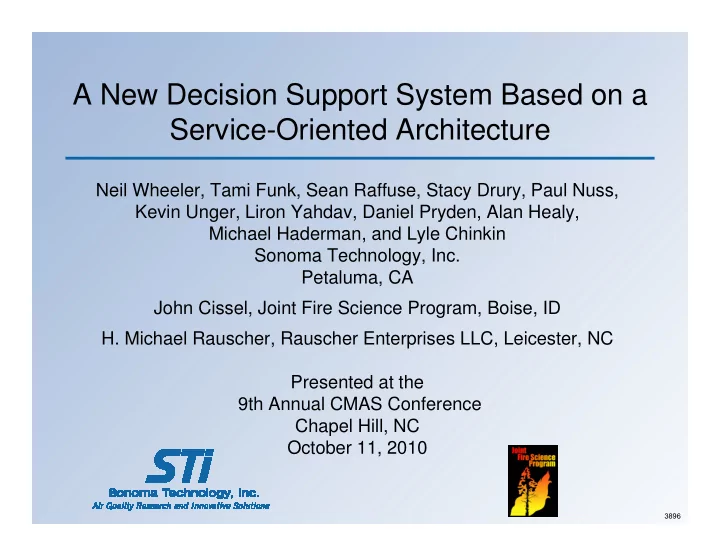

A New Decision Support System Based on a Service-Oriented Architecture Neil Wheeler, Tami Funk, Sean Raffuse, Stacy Drury, Paul Nuss, Kevin Unger, Liron Yahdav, Daniel Pryden, Alan Healy, Michael Haderman, and Lyle Chinkin Sonoma Technology, Inc. Petaluma, CA John Cissel, Joint Fire Science Program, Boise, ID H. Michael Rauscher, Rauscher Enterprises LLC, Leicester, NC Presented at the 9th Annual CMAS Conference Chapel Hill, NC October 11, 2010 3896
Introduction • Joint Fire Science Program (JFSP) • Design issues • Software Tools and Systems (STS) study • Interagency Fuels Treatment Decision Support System (IFT-DSS) • JFSP vision In a distributed collaboration environment, In a distributed collaboration environment, what we want is … what we want is … • STS future …that can …that can take its place take its place within the within the context of a context of a mission mission • An approach, not environment environment …that can be …that can be configured into the configured into the capability required for capability required for a solution a given operation… a given operation… …conforming to …conforming to key interface key interface standards... standards... Source: Carnegie Mellon Software Modular, reusable Modular, reusable Engineering Institute elements... elements... 2
Design Issues • Multiple communities • Implementation restrictions – Multiple agencies – IT policies – Skill levels • Overlapping process implementations – Science – Interfaces – Modularity 3
Multiple Communities 4
JFSP Vision 5
Design Approach • Community engagement • Workflows • Service Oriented Architecture (SOA) • Separation of functions – User interface – Scientific modeling framework – Models • Process level science 6
Service Oriented Architecture • A generic software architecture framework designed to support a collection of services, such as databases and software applications • Has well-defined software and data interfaces • Facilitates the integration of new and legacy software applications • Facilitates inter-operability with other systems 7
Architecture (1 of 3) IFT-DSS Application (User Interface) Components Scientific Modeling Framework (SMF) Models 8
Architecture (2 of 3) IFT-DSS topology and the communication mechanisms 9
Architecture (3 of 3) Model Integration Methods 10
Implementation Schedule • Prototype – completed (June 2010) – Functional – One workflow – Limited GIS capability – All model interfaces • Development and testing – Version 1.0 (June 2011) – Version 2.0 (June 2012) • Enterprise operations – fall 2012 11
Discussion • SMF is applicable to any discipline • The SOA facilitates access to authoritative systems that are external to a DSS • Some of the approaches to model integration in the IFT-DSS might be transferable to the integration of process-level science in meteorological, emissions, and air quality modeling 12
Summary and Conclusions • A DSS is more than a model • The development of an effective and sustainable DSS requires the participation of a community • The STS study and IFT-DSS attempt to address long-standing issues with modularity and model interactions in the fuels treatment community • The CMAS community faces many of the same challenges and might benefit from the lessons learned and engineering practices employed as a result of the STS study 13
Acknowledgments Joint Fire Science Program Fuels Management Committee Test User Group Collaborating Fire Scientists 14
Questions Ms. Tami Funk IFT-DSS Project Manager Sonoma Technology, Inc. tami@sonomatech.com JFSP STS Study http://frames.nbii.gov/jfsp/sts_study IFT-DSS http://www.firescience.gov/JFSP_IFFT-DSS.cfm 15
Recommend
More recommend